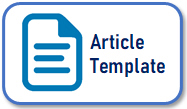Characterization Roasting Level of Arabica Coffee (Coffea arabica) Komasti and Andungsari
Abstract
Coffee is one of the drinks that are often consumed by the public Indonesia. Indonesian Coffee and Cacao Research Institute (ICCRI) is a national coffee and cocoa research and development institution has 2 superior Arabica coffee seeds, namely Andungsari 2K Arabica Coffee and Komasti (Andungsari 3 Composite). In general, the sequence of dry processing of coffee cherries includes fruit picking, fruit sorting, fruit drying, pulping and hulling. Next is the roasting process before it becomes coffee grounds. The roasting process converts unsavory raw coffee beans into a drink with a delicious aroma and taste. The perfection of coffee roasting is influenced by 2 factors, namely heat and time, equipment and tools roasting and quality of coffee beans. From the results of treatments 2, 4, 6, 8, 10, 12, 14, 16 and 18 minutes, coffee with city roast criteria was produced in the 7th treatment, namely 14 minutes, with the first crack at 11.30 minutes at 154 °C, the color of the beans dark chocolate, has the most popular taste. For treatment 8 (14 minutes) and 9 (18 minutes) the color is more black, oily and smokey, the taste is more espresso. The roasting equipment used is in the dark roast category at a temperature of 170-195 °C.
Keywords
Full Text:
PDFReferences
Afriliana, A. (2018). Teknologi Pengolahan Kopi Terkini. Deepublish.
Aklimawati, L., Yusianto, & Mawardi, S. (2014). Characteristic of Quality Profile and Agribusiness of Robusta Coffee in Tambora Mountainside Sumbawa. Pelita Perkebunan, 30(2), 159–180.
Belay, A., & Gholap, a. V. (2009). Characterization and determination of chlorogenic acids ( CGA ) in coffee beans by UV-Vis spectroscopy. African Journal of Pure and Applied Chemistry, 3(11), 234–240. https://doi.org/10.5897/AJPAC
Bicho, N. C., Leitão, A. E., Ramalho, J. C., & Lidon, F. C. (2011). Identification of chemical clusters discriminators of the roast degree in Arabica and Robusta coffee beans. European Food Research and Technology, 233(2), 303–311. https://doi.org/10.1007/s00217-011-1518-5
Cahyani, Y. N., Kristiningrum, N., & Wulandari, L. (2015). Perbandingan Kadar Fenol Total Dan Aktivitas Antioksidan Ekstrak Metanol Daun Kopi Robusta (Coffea canephora) Dan Arabika (Coffea arabica). In Digital Repository Universitas Jember. http://repository.unej.ac.id/
Cämmerer, B., & Kroh, L. W. (2006). Antioxidant activity of coffee brews. European Food Research and Technology, 223(4), 469–474. https://doi.org/10.1007/s00217-005-0226-4
Farah, A. (2012). Coffee Constituents. In Y. Fang Chu (Ed.), Coffee: Emerging Health Effects and Disease Prevention (First Edit, pp. 21–58). John Willey & Sons, Inc and Institute of Food Technologies (USA)). https://doi.org/10.1002/9781119949893.ch2
Fujioka, K., & Shibamoto, T. (2008). Chlorogenic acid and caffeine contents in various commercial brewed coffees. In Food Chemistry (Vol. 106, Issue 1). https://doi.org/10.1016/j.foodchem.2007.05.091
Hečimović, I., Belščak-Cvitanović, A., Horžić, D., & Komes, D. (2011). Comparative study of polyphenols and caffeine in different coffee varieties affected by the degree of roasting. Food Chemistry, 129(3), 991–1000. https://doi.org/10.1016/j.foodchem.2011.05.059
Henrica, A. (2017). Inventarisasi organoleptik, kandungan kafein, dan asam klorogenat pada kopi bubuk robusta (. 27.
Higdon, J. V., & Frei, B. (2006). Coffee and health: A review of recent human research. Critical Reviews in Food Science and Nutrition, 46(2), 101–123. https://doi.org/10.1080/10408390500400009
Jaiswal, R., Patras, M. A., Eravuchira, P. J., & Kuhnert, N. (2010). Profile and characterization of the chlorogenic acids in green Robusta coffee beans by LC-MSn: Identification of seven new classes of compounds. Journal of Agricultural and Food Chemistry, 58(15), 8722–8737. https://doi.org/10.1021/jf1014457
Kath, J., Mittahalli Byrareddy, V., Mushtaq, S., Craparo, A., & Porcel, M. (2021). Temperature and rainfall impacts on robusta coffee bean characteristics. Climate Risk Management. https://doi.org/10.1016/j.crm.2021.100281
Mangiwa, S., & Maryuni, A. E. (2019). Skrining Fitokimia dan Uji Antioksidan Ekstrak Biji Kopi Sangrai Jenis Arabika (Coffea arabica) Asal Wamena dan Moanemani, Papua. Jurnal Biologi Papua, 11(2), 103–109. https://doi.org/10.31957/jbp.925
Purnamayanti, N. P. A., Gunadnya, I. B. P., & Arda, G. (2017). Pengaruh Suhu dan Lama Penyangraian terhadap Karakteristik Fisik dan Mutu Sensori Kopi Arabika (Coffea arabica L). Jurnal BETA (Biosistem Dan Teknik Pertanian, 5(2), 39–48.
Specialty Coffee Association of America SCAA. (2013). Defect Handbook.
Sugiyono. (2018). Metode Penelitian Kombinasi (Mixed Method). CV Alfabeta.
Sutarsi, Rhosida, E., & Taruna, I. (2016). Penentuan Tingkat Sangai Kopi Berdasarkan Sifat Fisik Kimia Menggunakan Mesin Penyangrai Tipe Rotari. Prosiding Seminar Nasional APTA, 2008, 306–312.
Tamilmani, P., & Pandey, M. C. (2015). Optimization and Evaluation of phenolic compounds and their antioxidant activity from coffee beans . International Journal of Advanced Research, 3(4), 296–306.
Yusianto, Hulupi, R., Sulistyowati, Mawardi, S., & Ismayadi, C. (2007). Physical and Flavor Quality of Some Potential Varieties of Arabica Coffee in Several Interval Storage Periods. Pelita Perkebunan, 23(4), 206–230.
Refbacks
- There are currently no refbacks.




